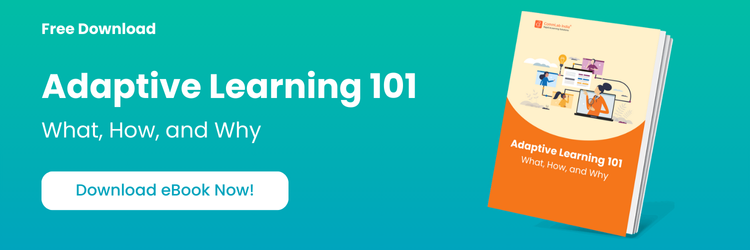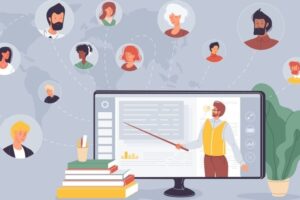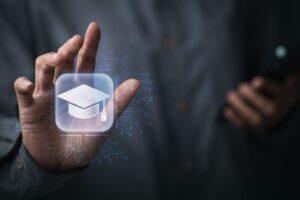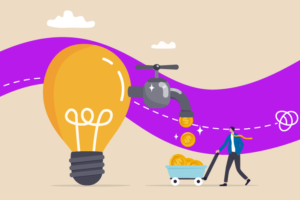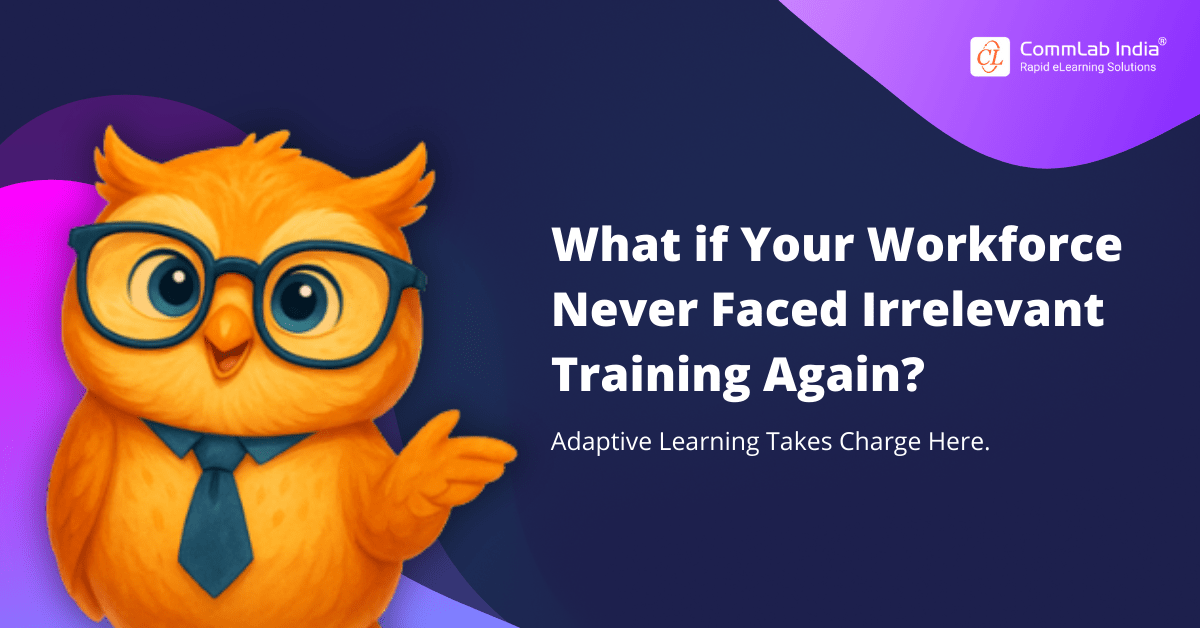
Smarter Paths to Workforce Readiness
For years, corporate training has been trapped in a paradox. Everyone agrees that learners have different roles, experiences, and prior knowledge, yet most organizations still deliver the same courses in the same way to everyone.
The result? Training feels too basic for some, overwhelming for others, and forgettable for most. Enter adaptive learning platforms.
These systems promise to change the rules by personalizing learning at scale. Instead of dragging employees through one-size-fits-all programs, they adjust the pace, sequence, and type of content in real time. But how do they really work, and why should L&D leaders pay attention? Here are five big questions worth asking.
Download eBook: Adaptive Learning 101
Table Of Content
What Is an Adaptive Learning Platform?
Adaptive learning platforms fundamentally use algorithms, AI, and learner data to shape a training journey that changes in real time.
Key differentiators include:
- Dynamic learning paths – no two learners follow the same sequence.
- Continuous diagnostics – performance is measured constantly, not just at the end of a module.
- Content flexibility – modular assets are recombined depending on learner need.
- Personalization at a scale – every employee gets a tailored journey, even in organizations with thousands of learners.
Example: In safety training, a new hire may work through guided visual modules, while an experienced employee is pushed straight into complex hazard simulations. Both finish the program, but neither wastes time on irrelevant material.
The critical shift is this: adaptive platforms don’t just deliver content. They build competence by learning the learner.
Watch How AI-Powered Adaptive Learning Paths Transform Corporate Training
How Do Adaptive Learning Platforms Work?
At the core of adaptive learning is a continuous feedback loop between the learner and the system. Every interaction provides data, and every data point shapes what comes next.
The process typically unfolds in six stages:
- Baseline diagnostics – Quick assessments, role profiles, or past performance data establish what the learner already knows and where gaps exist.
- Decision engine – Algorithms analyze this information and determine the best next step: advance, reinforce, or redirect.
- Targeted content delivery – The system selects and delivers the most relevant asset, whether that’s a microlearning video, an interactive simulation, or a quick knowledge check.
Discover Microlearning Solutions from CommLab India to Boost Employee Performance
- Continuous monitoring – Every response, hesitation, and action is tracked in real time, building a rich picture of learner behavior.
- Dynamic adjustment – The learner’s pathway is updated instantly. Struggling learners get reinforcement; advanced learners move on to more complex challenges.
- Analytics dashboards – L&D leaders receive insights into individual and group performance, highlighting skill mastery levels, bottlenecks, and progress trends.
Modern platforms extend this foundation with predictive analytics to flag disengaged learners, contextual adaptivity to adjust for different work environments (frontline vs. office), and personalized gamification to keep motivation high.
The real power lies in the adaptability itself. These platforms don’t simply record completions—they continuously fine-tune the difficulty and experience, so learners remain in the optimal zone between challenge and competence. That’s where learning sticks.

Which Benefits Make Adaptive Learning Stand Out?
Adaptive learning isn’t just another technology upgrade; it changes the very equation of how organizations measure and deliver training. Its advantages are felt at two levels: the individual learner and the business.
For Learners
- Time Efficiency: Learners don’t waste hours covering material they already know. Training adapts to their pace, cutting unnecessary seat time.
- Relevance: Every module feels targeted and useful. This eliminates the “why am I here?” disengagement that plagues generic courses.
- Confidence Through Mastery: Learners move forward only when they demonstrate understanding, which builds competence and trust in their own skills.
- Accessibility and Flexibility: Adaptive systems can flex around language needs, learning styles, or accessibility requirements, ensuring nobody is left behind.
For Organizations
- Competence Over Compliance: Instead of just tracking completions, adaptive learning measures whether employees can actually apply knowledge.
- Personalization at Scale: Thousands of employees can each have a unique path, without multiplying design and development effort.
- Sharper Business Insights: Dashboards show exactly where knowledge gaps exist, which skills are being mastered, and which teams are falling behind.
- Proven ROI: Adaptive learning shortens training time while improving retention — giving executives tangible evidence of performance gains and among 37 recent studies examining adaptive learning, 86% reported positive effects on learning outcomes.

Which Training Areas Should L&D Prioritize for Adaptive Learning?
The promise of adaptive learning can feel overwhelming. Many L&D leaders make the mistake of thinking they need to transform their entire training strategy overnight. The smarter approach is to start small, prove value, and then scale.
Here are four practical entry points where adaptive learning consistently delivers impact:
Onboarding Programs
No two new hires start from the same place. Some arrive with industry knowledge, while others are fresh to the field. Adaptive learning allows onboarding to flex around these differences — accelerating productivity for experienced hires while giving new employees the extra support they need. The result is a faster ramp-up and less wasted time on content that feels redundant.

Adaptive Learning 101
Explore the What, the Why, and the How!
- Introduction to Adaptive Learning
- Levels of Adaptive Learning
- Examples
- Case Studies
Compliance Training
Compliance is mandatory but often dreaded. Adaptive platforms transform it by tailoring the depth of content. Employees who demonstrate mastery can move quickly, while others receive reinforcement until they meet the standard. This approach reduces seat time without compromising rigor — and helps ensure true compliance across the workforce.
Sales and Customer-Facing Roles
Salespeople and customer service staff thrive when training is personalized to their role and skill level. Adaptive platforms can deliver targeted product updates, customer scenarios, or negotiation challenges based on individual performance data. This translates into more consistent customer experiences and stronger sales outcomes.
Technical and Digital Skills
In fields like IT, cybersecurity, and AI, skills change faster than traditional training cycles can manage. Adaptive systems provide just-in-time interventions, ensuring employees get exactly the support they need when they need it. This minimizes errors, builds confidence, and keeps teams future ready.
Rule of Thumb for L&D Leaders
Start where the stakes are high and measurement is easy. Quick wins in compliance or onboarding prove the model and build stakeholder confidence. Once adaptive learning has delivered results in one area, scaling into leadership, reskilling, and enterprise-wide initiatives becomes much easier.
Emerging Trends in Adaptive Learning
Which Adaptive Learning Platforms Should L&D Leaders Explore?
Here are a few:
- Adaptemy – Adaptive assessments, curriculum mapping, guided reinforcement, and LMS integration with detailed learner analytics.
- Knewton Alta (by Wiley) – Adaptive content for STEM with personalized study plans and real-time feedback for mastery.
- Realizeit – Adaptive pathways for onboarding, compliance, and reskilling, with powerful knowledge progression tracking.
- Area9 Rhapsode – Cognitive science–based adaptive platform that uncovers hidden gaps and ensures mastery learning at scale.
Adaptive learning platforms are already a leap forward compared to traditional training, but they’re still largely reactive. They respond to learner actions and adjust accordingly. The next frontier is making them proactive — systems that don’t just adapt to learners but actively guide and accelerate their growth.
Here are some trends already taking shape:
AI Coaches in the Flow of Work
Future platforms will integrate directly with daily tasks, nudging employees with micro-lessons exactly when they’re needed. Imagine a system that notices a salesperson preparing for a negotiation and instantly delivers a 3-minute refresher on objection handling. Training becomes contextual, timely, and invisible.
Career Pathing and Talent Mobility
Adaptive learning data won’t stay confined to L&D dashboards. It will connect to talent management systems, mapping skill mastery to promotion opportunities, succession planning, and reskilling programs. Training will no longer be about courses; it will be a career accelerator.
Immersive and Real-Time Adaptivity
With VR and AR, adaptive training will become more experiential. Instructional design will evolve to create simulations that shift in real time, a leadership scenario might change its storyline depending on how a manager handles conflict, while a safety drill could escalate or de-escalate risks based on decisions made. This results in true-to-life practice environments that adapt just like the real world.
Emotional Intelligence Adaptivity
The next wave of adaptivity may go beyond knowledge and behavior, reading learner engagement, stress, or even overconfidence through biometric or behavioral signals. Corporate Training could then adjust its pacing, difficulty, or feedback style — offering personalized support for both skill and mindset.
From Training to Continuous Learning Ecosystems
Ultimately, adaptive learning will dissolve the boundary between “training” and “work.” Learning won’t happen in scheduled courses; it will be embedded into workflows, with AI acting as a co-pilot — anticipating needs, providing resources, and tracking progress continuously.
Your Next Step with Adaptive Learning
Adaptive learning platforms are no longer a futuristic idea, they are today’s answer to the long-standing challenges of corporate training. By shifting from one-size-fits-all courses to personalized, data-driven pathways, they make learning faster, more relevant, and easier to measure. For learners, the benefit is confidence and efficiency. For organizations, it’s competence at scale and proof of ROI.
But adopting adaptive learning is not about technology alone. It’s about choosing the right starting point, preparing quality content, and aligning training outcomes with business goals. L&D leaders who take a strategic approach can transform training from a compliance exercise into a driver of workforce readiness and performance.
The real question isn’t whether adaptive learning works — it’s how quickly you’ll use it to build a learning culture that keeps pace with change. This eBook is your quick guide to understanding adaptive learning and how it can help you deliver personalized training at scale with measurable business impact. Learn how to unlock personalized training at scale and speed — download now.



